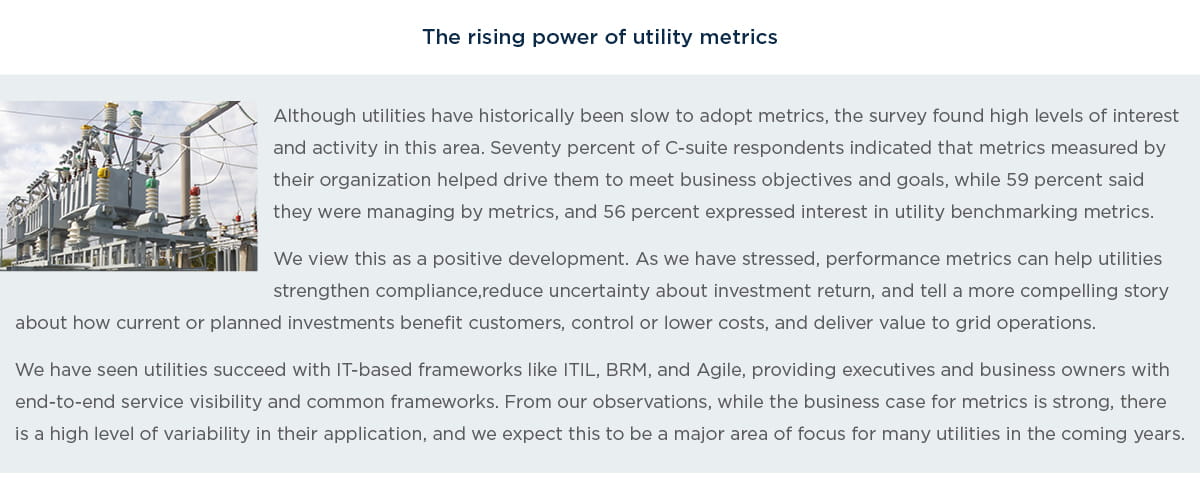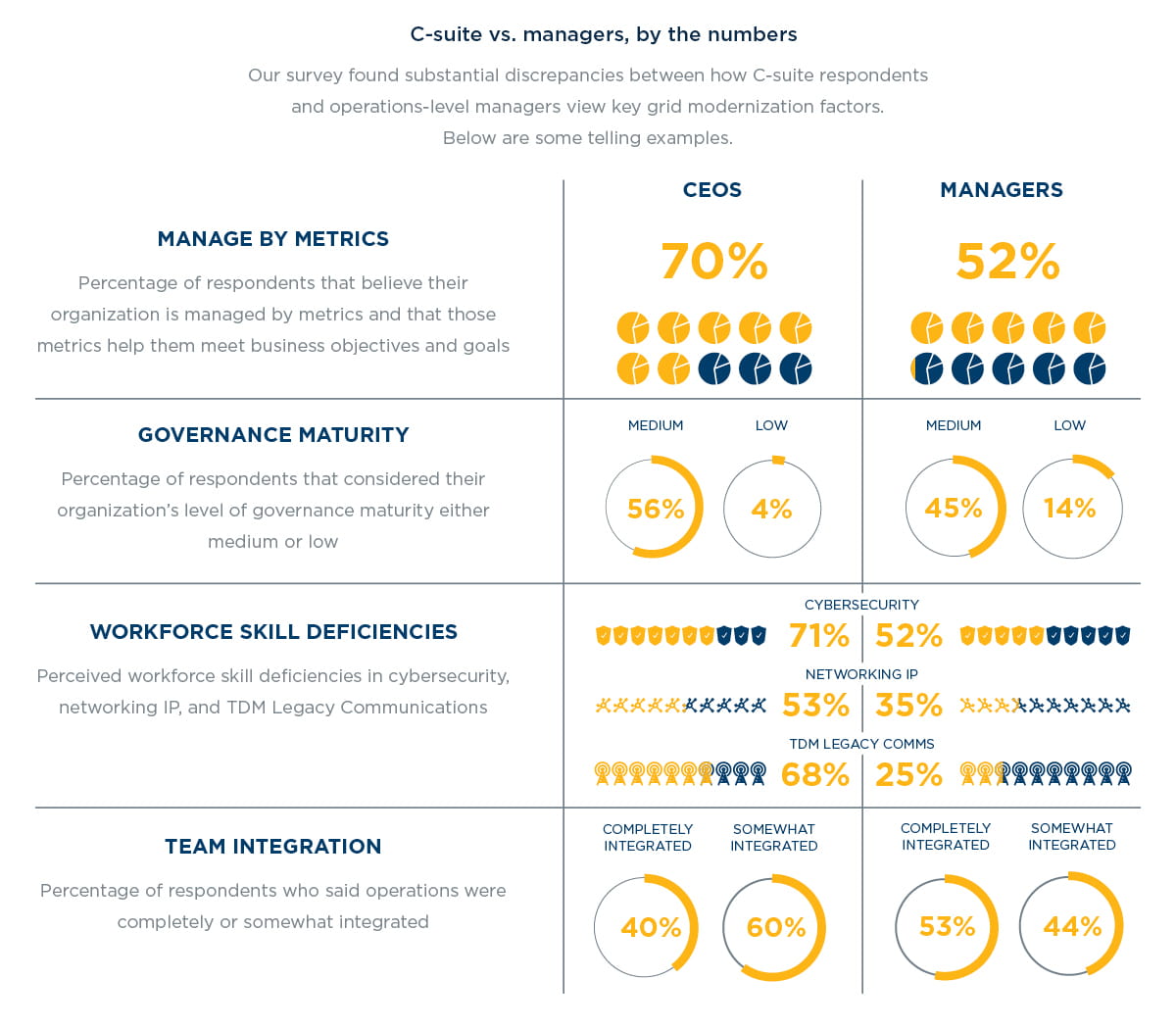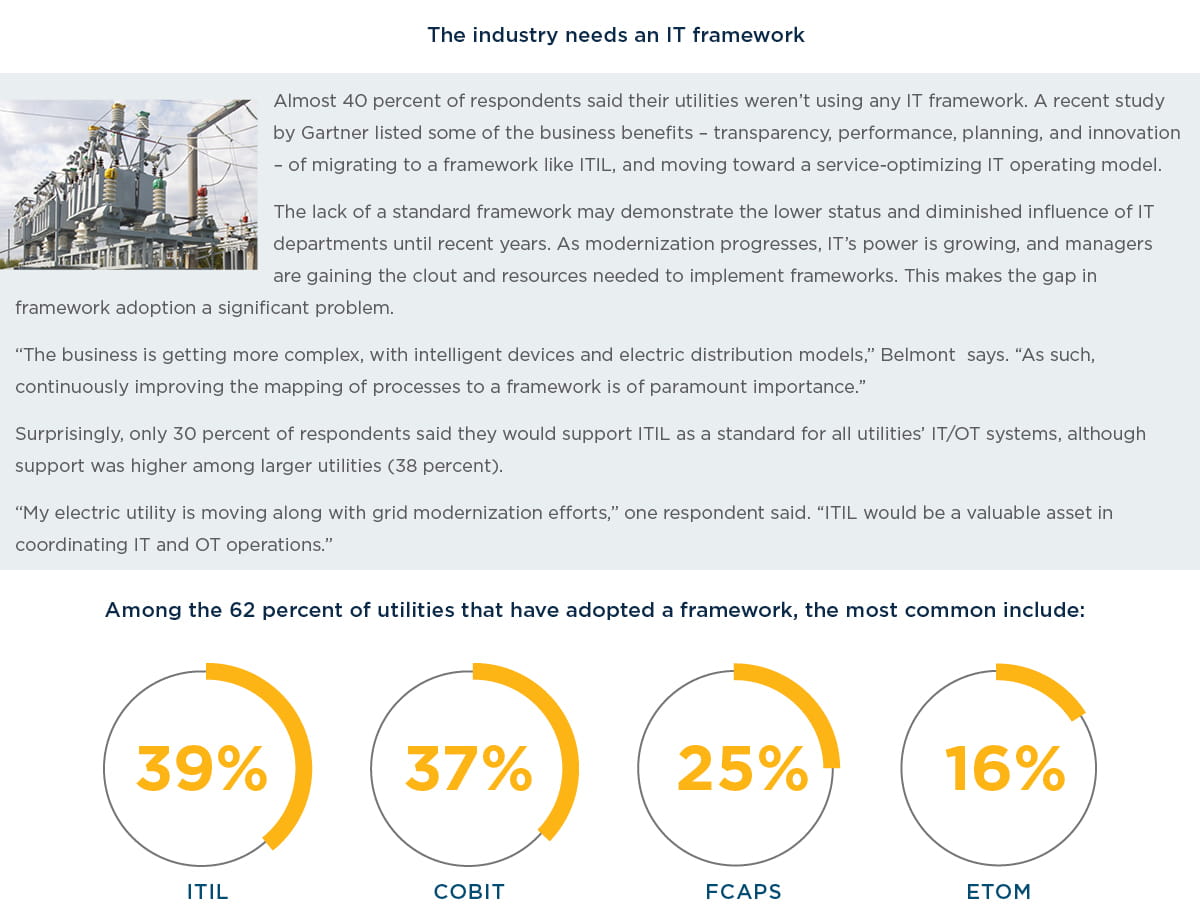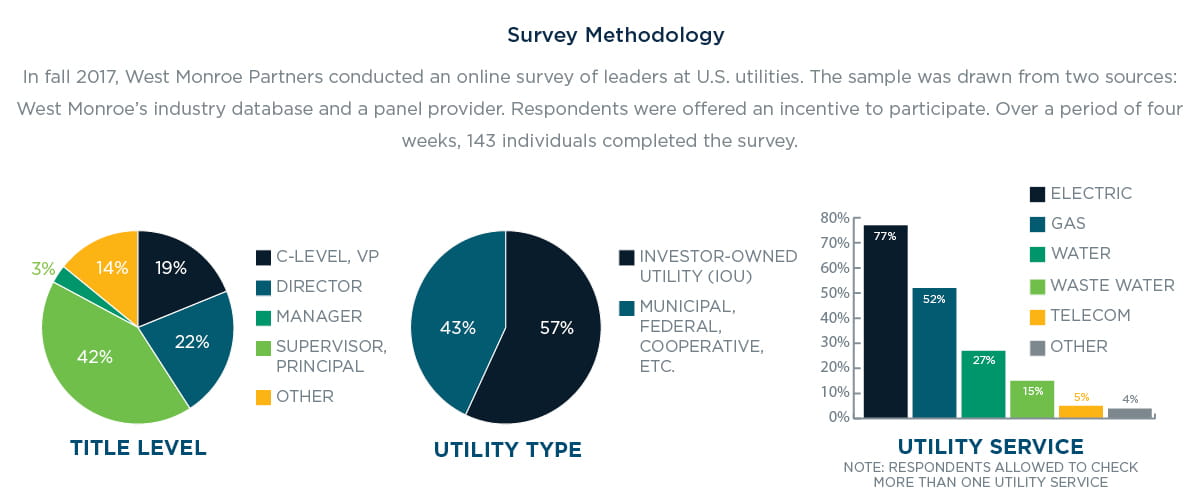
January 2018 | Signature Research
Managing Grid Modernization: Integrating IT and Operations at U.S. Utilities
Learn how utilities are handling the integration of IT and OT services amid heightened cybersecurity concerns
get the full reportEven as U.S. utilities make substantial headway on grid modernization, many lag stubbornly behind on key aspects of integrating information technology and operations systems and work groups. And investor-owned utilities (IOUs) have made surprisingly little progress toward that integration.
Those are among the key findings in our recent survey of 143 utility executives and managers. The survey results portray a sector making meaningful but halting progress on its most pressing technological challenges.
Technology now pervades everything utilities do. Automation, two-way communications, smart metering, and variable rate structures are a reality for many, and the future for all. These technologies have been proven, and an aging workforce has rendered utilities unable to operate as in the past. The bottom line: In a world of inevitable, relentless change, pressure to innovate is intense. It is coming from all sides, including consumers, regulators, and shareholders.
But for utilities, this change doesn’t come easy, and doesn’t occur in a vacuum. It means restructuring, embracing change, and getting comfortable with greater risk. Utilities are undertaking an integration of complex processes and work groups—particularly between IT and OT—that have historically been siloed into different departments. This shift is especially challenging when in the past change was incremental and organizations were accustomed to business as usual. In a world of shifting regulations, unparalleled technology advancement, and evolving business models, planning for the future has never been more important.
Survey Highlights
More than half of our utility executive respondents had to restructure their organizations based on the impacts of grid modernization efforts. To accommodate change, a third of those surveyed had to: implement new governance structures, reorganize staff and roles between IT and OT, change leadership to improve awareness, and outsource IT expertise when needed. Most realize this trend of reorganization will grow given those that have not started or have just begun.
Some companies expressed strong confidence in their modernization efforts. “I think we are in a good place,” said one respondent. Most respondents, however, rated their maturity level in key support areas as average, and some recognized that they could benefit from outside assistance. “It would be helpful to bring in consultants,” one wrote. Another concluded, “Moving past legacy equipment before it sunsets is very difficult in a geographically diverse environment.”
Most significantly, the survey uncovered a disconnect between the perceptions of the C-suite and the directors and managers who report to them, potentially owing to gaps between these two groups’ cultures, priorities, and expectations.
“To drive grid modernization to the next level, utilities must focus on strengthening and optimizing their organizational structure and culture,” said Daniel Belmont senior director in West Monroe’s Energy & Utilities practice. “Right now, change is causing confusion and fatigue within utilities. Executives are making decisions based on business needs, but with change happening so rapidly they need to be more strategic about implementation. They need to concentrate more on communicating their vision, building stronger cultures, and bridging the gap between the C-suite and the rank and file.”
Chapter 1: Disconnect: C-suite vs. managers
The survey identified discrepancies between the C-suite and managers in terms of how they viewed the status of operational convergence within their organizations. The discrepancy cut across a variety of topics, but in general the C-suite tended to be bullish on managerial processes and bearish on workers’ capabilities.
In particular, the C-suite was more likely to believe their utilities had installed manager-of-managers systems, implemented strong governance models, and managed according to metrics. On the other hand, they were more likely to report integration limitations, change management deficiencies, and worker skills deficits, particularly in cybersecurity, networking IP, and TDM legacy communications.
It’s not unusual for large organizations to experience a disconnect between the executive suite and managers. This is especially true for large IOUs who are grappling with distinct organizations spread across a large geographical area or even across multiple states. However, the discrepancy identified may be emblematic of an expanding gap in the cultural shift underway in the utility sector.
The survey results showed managers may view workers’ skills more approvingly because managers are attuned to the day-to-day demands of utility operations, or because the managers may be benchmarking the skills against traditional expectations, such as management of poles, lines, and transformers. Meanwhile, the C-suite is bombarded from all sides – advisors, the market, utility commissions, and consumers – with rhetoric about the need for modernization.
So, it’s no surprise that leadership is driving the shift toward digitization – and encountering a series of vexing internal impediments, emanating in part from a legacy workforce with veteran technicians (and managers) who are highly skilled in working on existing networks but who may be less comfortable in learning emerging technologies. Even more fundamentally, the survey depicts a division between managers who are focused on the immediate need to keep electrons, water, or gas flowing, and C-suites trying to move their organizations into the future.
Correspondingly, C-suite respondents put a much lower premium on nurturing front-line talent than managers. Only 26 percent of C-suite respondents chose “retaining and growing the necessary skills among staff” as a top concern, placing it at the bottom of the priority list. In contrast, 45 percent of managers viewed retention and training as a priority, ranking it behind only cybersecurity.
“There’s a lot of knowledge walking out the door at utilities as workers retire,” says Tim Valin, a West Monroe senior manager serving utilities. “Many in the C-suite may underestimate how this affects their business at the operating level, and how valuable these employees are.”
Cybersecurity topped the list of C-suite concerns, cited by 70 percent of C-suite respondents, followed by governance (59 percent). These priorities underscore the pre-eminence of technology challenges weighing on the minds of utility executives.
Chapter 2: Are cybersecurity concerns delaying IT/OT integration?
The survey found that a minority of IT and operational teams were still using separate, information systems. Sixty-five percent said they were sharing asset management systems, 61 percent shared knowledge management, and 59 percent shared a common ticketing system. Interestingly, IOUs lag other utilities in this area. For example, only 52 percent of IOUs said they shared knowledge management systems, versus 72 percent of non-IOUs. Given the efficiencies inherent in centralizing systems, a significant portion of the industry could reap cost savings and improve performance by moving more aggressively on convergence.
What’s delaying the IT/OT convergence? There are a number of possible explanations. One is that cybersecurity concerns are prompting utilities to move cautiously on technology integration. This may account for the slow progress at IOUs, which otherwise tend to be proactive in technology investments. Our survey found that cybersecurity was far and away the top concern (67 percent) in managing converged IT/OT systems. Moreover, a majority (55 percent) said cybersecurity NERC-CIP was the top skill or certification that utility workforces need. These assertions held true regardless of the title of the respondent, or the size or type of utility they represented.
“It’s hardly surprising that the industry is concerned about cyber-attacks, whether from foreign governments or non- state actors, nor is it news that such attacks have already occurred and are proliferating,” Belmont says. “In addition to the usual headaches accompanying a service disruption, an attack carries significant reputational risks, which may prompt heightened caution from leadership at IOUs, given shareholder sensitivities to bad news – and given that C-suite executives will inevitably be held accountable in the event of a significant breach.”
The risks that cyber threats pose to utilities should not be taken lightly by anyone in the organization. As utilities continue to integrate their IT and OT work groups, special attention will need to be paid to the security of their systems and processes. The integration of these groups and processes is possible, but only through deliberate and thoughtful planning and actions.
Integration of IT/OT
One of the most promising upsides of utility digitization and the convergence of IT/OT is the ability to monitor and gauge the health of the grid quickly and efficiently, on a single computer screen. Such manager-of-managers systems can dramatically improve workforce efficiency. In contrast, utilities that still rely on disparate systems — with managers swiveling between screens, or attempting to coordinate teams with disparate, narrow responsibilities — can suffer longer outages or even miss outages.
Despite this, only 62 percent of respondents said that they had such a “single pane of glass”; the rest either didn’t have one (22 percent) or didn’t know (16 percent). Electric utilities, and particularly IOUs, were more likely than other respondents to say they didn’t have one; only 57 percent of IOUs responded affirmatively.
“Deploying these technologies at larger, investor-owned utilities carries substantial complexities,” says Jodi Bednar, a West Monroe senior principal who works with utilities. “A number of large utilities are hard at work on this, and we expect new systems to be implemented soon. Laggards stand a real chance of being left behind if they don’t explore their options soon.”
Conclusion
Gaps between the C-Suite and managers are not uncommon. However, traditional utilities are challenged more than ever to keep pace with changing expectations from customers and the market, which drive C-Suite expectations. The bigger the organization, the more layers and levels of complexity that exist—and automation, digitization, and “smart” components magnify this transformational challenge.
Utilities can help themselves by thinking about innovation, automation, robotics, and centralized control as a way to simplify “keeping the lights on”. However, this complicates the IT and OT side of the business, converting old, repeated, manual, and distributed tasks done by many to a consolidated, technical, centralized “click of a button” accomplished by just a few. To ensure that this meets and hopefully exceeds the service levels required for providing reliable power, utility IT and OT management must adopt a standard set of processes and monitoring and reporting tools to streamline the planning, building, measuring, and managing of complex technology solutions.
The most overlooked and critical component to successful optimization is documentation and vetting of the process prior to figuring out what technology or tool will be used to facilitate that change. The C-Suite and managers need to answer, “What do I want to improve and what is the desired outcome?” and then build a process for doing it, set the rules, and identify the right tools required to achieve success. By developing digital IT systems and processes that can be systematically monitored and managed, IT and OT systems can go from complex, individual tools to one seamless digital system that enhances grid reliability, reduces costs, and provides operational insights and predictions that can create significant business value.







